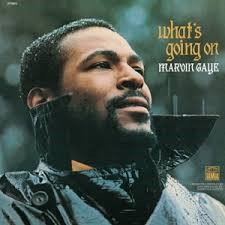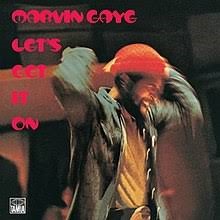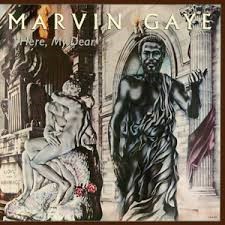Five of the best from Marvin Gaye
Five of the best from Marvin Gaye
- What's Going On (1971) - This concept album is widely regarded as Gaye's masterpiece. It addressed social and political issues and revolutionized soul music.
- Let's Get It On (1973) - Known for its sensual themes, this album solidified Gaye's reputation as a sex symbol and includes the iconic title track.
- I Want You (1976) - This album showcased Gaye's evolving style, blending soul with funk and disco influences.
- Here, My Dear (1978) - While initially underappreciated, this deeply personal album has gained recognition over time as one of Gaye's most honest and innovative works.
- Midnight Love (1982) - Gaye's final studio album, featuring the hit single "Sexual Healing," which became one of his most recognizable songs.
1. What's Going On (1971)

The1971 album "What's Going On" revolutionized soul music and left an indelible mark on popular culture. This concept album, addressing pressing social issues like poverty, drug abuse, and the Vietnam War, showcased Gaye's evolution as an artist and social commentator. The album's smooth, jazzy sound and introspective lyrics set it apart from typical Motown productions of the era. Gaye's soulful vocals, layered over complex arrangements, created a rich sonic landscape that captivated listeners.
"What's Going On" topped charts and garnered critical acclaim, establishing itself as a landmark in music history. Its themes of environmentalism, civil rights, and urban struggle remain relevant today, cementing its status as a timeless masterpiece. The album's influence extends beyond music, inspiring generations of artists across genres to create socially conscious art. "What's Going On" stands as a testament to Gaye's artistic vision and his ability to capture the spirit of the time.
2. Let's Get It On (1973)

"Let's Get It On" (1973) solidified his status as a soul music icon and sex symbol. This album marked a shift from the socially conscious themes of his previous work to a more intimate, sensual sound. Gaye's smooth, passionate vocals and the album's lush instrumentation created an atmosphere of romance and desire. The title track became an instant classic, known for its seductive lyrics and memorable guitar riff. "Let's Get It On" explored themes of love, sexuality, and relationships, resonating with audiences and influencing R&B music for decades to come.
The album's commercial success, reaching multi-platinum status, demonstrated Gaye's ability to connect with listeners on a personal level. Its blend of soul, funk, and pop elements showcased Gaye's versatility as an artist and producer. "Let's Get It On" remains a cornerstone of 1970s soul music, celebrated for its musical innovation and frank approach to adult themes.
3. I Want You (1976)

"I Want You" showcased the artist's evolving sound, blending soul with funk and disco influences. This romantic and sensual album marked a departure from Gaye's earlier socially conscious work, focusing instead on themes of desire and passion. The production, featuring lush orchestration and intricate arrangements, created a dreamy, atmospheric sound that became a hallmark of Gaye's later work. Leon Ware's contributions as co-producer and songwriter helped shape the album's distinctive style.
"I Want You" demonstrated Gaye's ability to adapt to changing musical trends while maintaining his unique artistic vision. The album's title track became a chart-topping hit, further cementing Gaye's reputation as a soul music icon. With its innovative approach to R&B and its exploration of adult themes, "I Want You" influenced future generations of artists and remains a significant entry in Gaye's discography, showcasing his growth as both a vocalist and a producer.
4. Here, My Dear (1978)

The 1978 double album "Here, My Dear" stands as one of his most personal and introspective works. Created as part of his divorce settlement with Anna Gordy, the album delves deep into the complexities of love, marriage, and heartbreak. Initially met with mixed reviews and commercial underperformance, "Here, My Dear" has since gained recognition as a masterpiece of soul music. Gaye's raw, emotional vocals and brutally honest lyrics paint a vivid picture of his failed relationship, set against a backdrop of funk, jazz, and disco influences.
The album's unconventional structure and deeply autobiographical content pushed the boundaries of R&B, showcasing Gaye's artistic growth and willingness to take risks. Over time, "Here, My Dear" has been reappraised by critics and fans alike, earning praise for its musical innovation and psychological depth. This soul classic continues to influence artists exploring themes of love and loss, cementing its place in music history.
5. Midnight Love (1982)

"Midnight Love" (1982) marked a triumphant return for the soul legend after a period of personal struggles and creative hiatus. Released by Columbia Records, this album became Gaye's final studio work before his untimely death in 1984. "Midnight Love" showcased Gaye's ability to adapt to the evolving musical landscape of the early 1980s, blending his signature smooth vocals with contemporary funk and R&B sounds. The album's breakout hit, "Sexual Healing," became one of Gaye's most recognizable songs, earning him his first Grammy and revitalizing his career.
Produced in Belgium, the album reflected Gaye's European influences while maintaining his soulful roots. "Midnight Love" explored themes of romance, sexuality, and spiritual yearning, resonating with a wide audience and achieving both critical and commercial success. It stands as a testament to Gaye's enduring artistry and his impact on the evolution of R&B music, influencing generations of artists in its wake.
Recent Posts
Queen studio albums: A Review
Phil Collins Albums Ranked & Reviewed – Complete Guide to Every Studio Album
The best of Massive Attack
Let’s Make Magic
Book Your Event DJ Now




